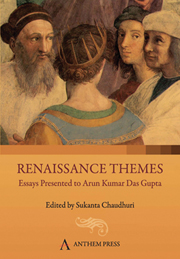Book contents
- Frontmatter
- Contents
- Preface
- List of Contributors
- Arun Kumar Das Gupta
- The Renaissance God as Man of Letters
- Ramist and Senecan Elements in Joseph Hall's The Art of Divine Meditation
- Hypocrite Lecteur: Reading on the Early Modern Stage
- Vertigo
- Folly and Androgyny: Shakespeare's King Lear
- ‘Fatal Visions’ in Macbeth
- The Miltonic Dissimile: Language and Style in Paradise Lost, Book 4
- ‘A Moving Grave’: Positioning Samson Agonistes
- Plate section
‘Fatal Visions’ in Macbeth
Published online by Cambridge University Press: 05 March 2012
- Frontmatter
- Contents
- Preface
- List of Contributors
- Arun Kumar Das Gupta
- The Renaissance God as Man of Letters
- Ramist and Senecan Elements in Joseph Hall's The Art of Divine Meditation
- Hypocrite Lecteur: Reading on the Early Modern Stage
- Vertigo
- Folly and Androgyny: Shakespeare's King Lear
- ‘Fatal Visions’ in Macbeth
- The Miltonic Dissimile: Language and Style in Paradise Lost, Book 4
- ‘A Moving Grave’: Positioning Samson Agonistes
- Plate section
Summary
Art thou not, fatal vision, sensible
To feeling as to sight?
(Macbeth, 2.1.36–7)Macbeth's anxious question to the air-borne dagger underscores the ambivalence in the manifestations of sight in this play: the dichotomies between what he sees and what he does not see, what he ought to see and what he ought not to see. Within a theatrical text, this opens up particularly interesting possibilities because the visual is a major signifier in the theatre, expected to work in tandem with the verbal/aural signifiers in order to constitute the performance.
In Renaissance England, there seems to have been a shift from the earlier dispensation of ‘hearing’ a play to that of ‘seeing’ a play. Scholars have often regarded Renaissance drama as ‘a confluence of the classical tradition of rhetoric and the native tradition of pageantry and spectacle’. In fact, the visual seems to have been increasingly prioritized over the verbal, so much so that the Jacobean spectators at the Fortune and the Red Bull theatres, comprising ‘the Citizens and the meaner sort of people’ according to Historia Histrionica (1699), are known to have clamoured for cruder forms of spectacular entertainment. No less a personality than Ben Jonson had to submit, however grudgingly, to the growing popularity of sight over sound. The two alternative Prologues for The Staple of News are illuminating in this context. The one written for the public stage declares that ‘he'd have you wise / Much rather by your ears than by your eyes’.
- Type
- Chapter
- Information
- Renaissance ThemesEssays Presented to Arun Kumar Das Gupta, pp. 98 - 112Publisher: Anthem PressPrint publication year: 2009



